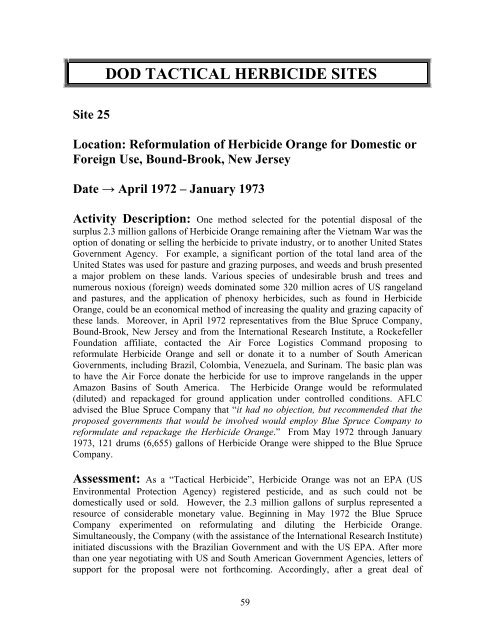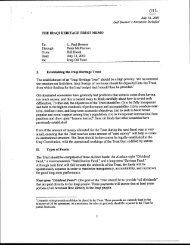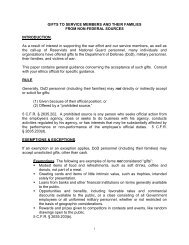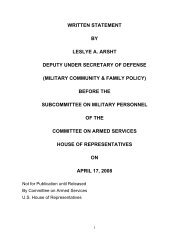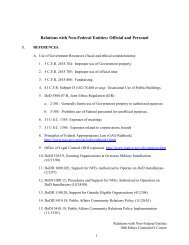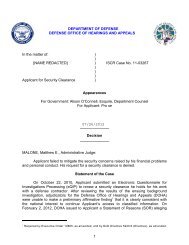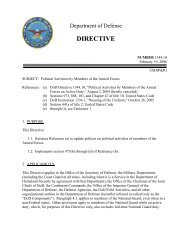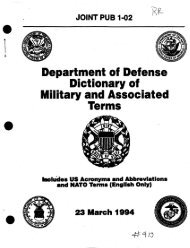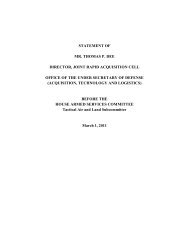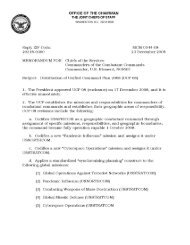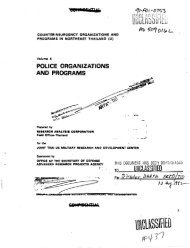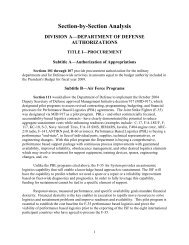dod tactical herbicide sites - United States Department of Defense
dod tactical herbicide sites - United States Department of Defense
dod tactical herbicide sites - United States Department of Defense
Create successful ePaper yourself
Turn your PDF publications into a flip-book with our unique Google optimized e-Paper software.
DOD TACTICAL HERBICIDE SITESSite 25Location: Reformulation <strong>of</strong> Herbicide Orange for Domestic orForeign Use, Bound-Brook, New JerseyDate → April 1972 – January 1973Activity Description: One method selected for the potential disposal <strong>of</strong> thesurplus 2.3 million gallons <strong>of</strong> Herbicide Orange remaining after the Vietnam War was theoption <strong>of</strong> donating or selling the <strong>herbicide</strong> to private industry, or to another <strong>United</strong> <strong>States</strong>Government Agency. For example, a significant portion <strong>of</strong> the total land area <strong>of</strong> the<strong>United</strong> <strong>States</strong> was used for pasture and grazing purposes, and weeds and brush presenteda major problem on these lands. Various species <strong>of</strong> undesirable brush and trees andnumerous noxious (foreign) weeds dominated some 320 million acres <strong>of</strong> US rangelandand pastures, and the application <strong>of</strong> phenoxy <strong>herbicide</strong>s, such as found in HerbicideOrange, could be an economical method <strong>of</strong> increasing the quality and grazing capacity <strong>of</strong>these lands. Moreover, in April 1972 representatives from the Blue Spruce Company,Bound-Brook, New Jersey and from the International Research Institute, a RockefellerFoundation affiliate, contacted the Air Force Logistics Command proposing toreformulate Herbicide Orange and sell or donate it to a number <strong>of</strong> South AmericanGovernments, including Brazil, Colombia, Venezuela, and Surinam. The basic plan wasto have the Air Force donate the <strong>herbicide</strong> for use to improve rangelands in the upperAmazon Basins <strong>of</strong> South America. The Herbicide Orange would be reformulated(diluted) and repackaged for ground application under controlled conditions. AFLCadvised the Blue Spruce Company that “it had no objection, but recommended that theproposed governments that would be involved would employ Blue Spruce Company toreformulate and repackage the Herbicide Orange.” From May 1972 through January1973, 121 drums (6,655) gallons <strong>of</strong> Herbicide Orange were shipped to the Blue SpruceCompany.Assessment: As a “Tactical Herbicide”, Herbicide Orange was not an EPA (USEnvironmental Protection Agency) registered pesticide, and as such could not bedomestically used or sold. However, the 2.3 million gallons <strong>of</strong> surplus represented aresource <strong>of</strong> considerable monetary value. Beginning in May 1972 the Blue SpruceCompany experimented on reformulating and diluting the Herbicide Orange.Simultaneously, the Company (with the assistance <strong>of</strong> the International Research Institute)initiated discussions with the Brazilian Government and with the US EPA. After morethan one year negotiating with US and South American Government Agencies, letters <strong>of</strong>support for the proposal were not forthcoming. Accordingly, after a great deal <strong>of</strong>59


